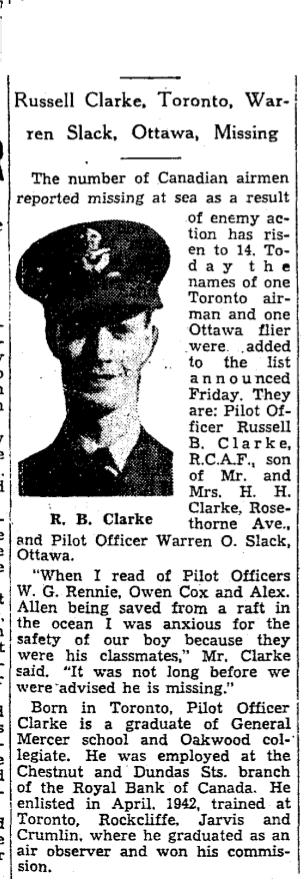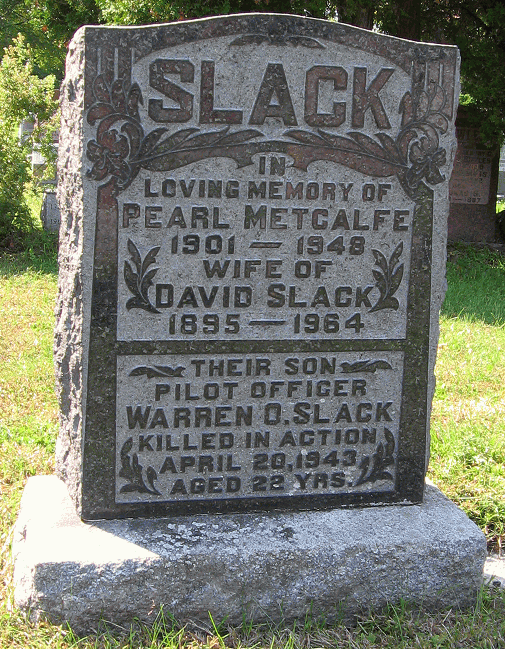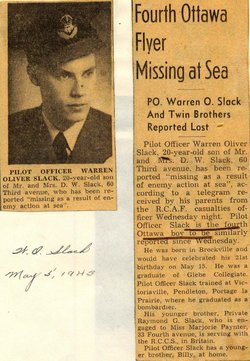


May 15, 1922 - April 22, 1943



Warren Oliver Slack, born in Brockville, Ontario, was the son of David William Slack (1883-1964), foreman carpenter with the Public Works Department, and Pearl Letitia (nee Metcalfe) Slack (1901–1948), of Ottawa. The family lived in Wanakena and Alexandria Bay, both in New York, plus Morrisburg, Ontario before settling in Ottawa. He had two brothers, Raymond Glen Slack (1923-1975) who had enlisted with the Canadian Army, posted overseas, and William David Slack, who was 10 in 1944. The family attended the United Church.
He had his junior matriculation with five senior matriculation subjects. He had 30 minutes as a passenger in an airplane. He liked to bowl, ski, and swim. He was on the track team at high school. While at school, Warren worked as a mill hand and a grocery packer at an A & P Store.
Warren worked at the Bank of Nova Scotia as a junior/student clerk prior to enlisting with the RCAF. He had been in that position for four months. After the war, he hoped to remain in one of the military services.
On October 31, 1940, on an enlistment form, Warren stood 5’10” and weighed 140 pounds, at the School of Instruction for Airmen (Medical Branch), Uplands, Ontario. “A young lad, intelligent and quick to learn. Good appearance. Proud of his appearance. Rather young to bear responsibility but will learn thoroughly and well. I think he can become an efficient clerk, and with his enthusiasm and keenness, he should get along well. He has my recommendation.” Lt. John Porter, RCAMC. “A very fine type of lad. Should prove worthy of the service. Above average.” He had blue eyes and fair hair, with a fair complexion. A scar from a boil was noted on his left scapula. “Neat and clean cut. Very good type. Suitability for medical orderly.”
Warren wore glasses for reading since he was three years old. On a form dated March 8, 1941, he was a medical clerk for the RCAF. Warren requested to remuster to become aircrew, by May 20, 1942, preferring to become a fighter pilot. His physique was wiry and his mentality: alert. “Intelligent lad with good average responses. Fit.” Lt. A. Rose, RCAMC. However, he had unsatisfactory ocular muscle balance and was not fit for pilot.
The RCAF sent him to No. 3 ITS, Victoriaville, Quebec on August 11 until October 10, 1941. He was 61st out of 79 in class with a 79%. “Intelligent, quiet, serious. Very good sense of duty. Good appearance. Excellent memory. Applies himself well, but his class results were disappointing. Good on parade.” Alternative recommendation: Air Bomber.
From there, he found himself at No. 10 EFTS, Pendleton, Ontario until November 18, 1942. “Young, but mature for his age.” Warren was in hospital for two days from August 6 to 8, 1942. He washed out from pilot training. “A below average student. Co-ordination and judgement of height and distance poor. Definite lack of air sense.” Warren failed his 20 hour test. “This trainee is not sure of himself. He has no idea of the circuit and his turns, landings, and forced landings are poor. Doubtful if he will ever make a service pilot. His progress is insufficient to warrant further training.” The Medical Officer stated, “Physically fit. Rather bright and intelligent. Serious and seems to know what he wants. Well-motivated. Should do well as a Navigator.” In Ground School, Warren was above average.
Warren was sent to Composite Training School (KTS) at Trenton, Ontario until December 4, 1942.
The RCAF decided Warren was fit to be an Air Bomber and was sent to No.7 B&G School in Paulson, Manitoba until February 6, 1943. “Navigation: pin pointing is poor. Slow to assimilate knowledge in the air. Logs need checking. Ground: Slow in mental problems and has a limited knowledge of details of theory.” Warren was 22nd out of 24 in his class with a 73.2%. “Some room for improvement in his appearance. Does not express himself clearly. Cooperative and willing.”
From there, he was sent to No. 7 AOS in Portage la Prairie, Manitoba, earning his Air Bomber’s Badge on March 19, 1943. He was in the hospital again from February 12 to 16, 1943.
Warren took out life insurance: $500 and $1,500, both making his mother sole beneficiary.
Warren traveled across the country to Halifax and was taken on strength at the Y Depot April 4, 1943. By April 14th, he was attached to the RAF Trainees’ Pool, awaiting transportation overseas.
On April 22, 1943, Warren was aboard the Amerika, British Motor merchant ship. It was on its way from Halifax, Nova Scotia to Liverpool. It was torpedoed as the ship was heading to Britain. It was a straggler in convoy HX-234. Thirty-seven men, all officers in the RCAF, were presumed missing as a result of enemy action at sea; sixteen were landed at a British port after their ship was sunk by U-306, south of Cape Farewell, off Greenland. Forty-two crew members and seven gunners were also amongst those who were lost. The master, Christian Nielsen, 29 crewmembers, eight gunners, and sixteen passengers were picked up by the HMS Asphodel, and landed at Greenock. General cargo, including metal, flour, meat and 200 bags of mail were also lost.
In late June 1943, Mrs. Slack received a letter from F/L Gunn, RCAF Casualties Officer, for Chief of the Air Staff, including a list of the names and next-of-kin of the sixteen RCAF Officers who survived. "Since my letter of May 6th, no additional news has been received. Attached is a list of the names and next-of-kin of sixteen Royal Canadian Air Force officers who embarked on the same ship as your son and following enemy action at sea were safely landed in the United Kingdom. The following official statement was made in the House of Commons....’I have been in receipt of communications from a number of members of this house and from people outside with reference to rumours regarding the recent loss of a number of members of the RCAF by the sinking of a ship in the north Atlantic and I desire to make the following statement on the facts. The vessel in question was a ship of British registry of 8,862 tons, designed for peace-time carriage of both passengers and freight, and having a speed of fifteen knots. She carried a crew of 86 and the passenger accommodation consisted of 12 two-berth rooms with bath and 29 other berths, providing cabin accommodations for 53 passengers. She was fitted with lifeboat capacity for 231 and travelled in naval convoy. Under the recently revised regulations agreed to by the United States authorities, the joint United Kingdom and United States shipping board, the Admiralty, the Air Ministry and the Canadian authorities, a vessel of this description travelling in convoy is permitted to embark as crew and passengers a maximum of 75% of the lifeboat capacity. The lifeboat capacity as stated above was 231, 75% of which is 173. Personnel on board consisted of the crew of 86, and RCAF personnel numbering 53, a total of 139, well within the prescribed limits. Because of the superior type of available passenger accommodation, the speed of the ship and the provision of naval convoy, the offer of the entire available space to the RCAF was immediately accepted. Rumours to the effect that this was a slow freighter not suitable for passenger accommodation are, of course, not in accord with the facts. Every precaution was taken to safeguard the lives of these gallant young men. It should be pointed out that on account of the serious shipping shortage every available berth on such ships must be used, and had the space not been taken up by the RCAF officers of the other arms of the services would have been placed on Board. It should also be stated again that the submarine is still the enemy’s most powerful weapon and that the Battle of the Atlantic is not yet won. Any ocean trip today in any part of the world is fraught with danger and I think I ay safely say that our record in transporting our soldiers and airmen to the United Kingdom is one of while we may all be proud. No one deplores more than I do the loss of 37 of the finest of our young men who gave their lives for their country as surely as if they had done so in actual combat with the enemy, and I extend my deepest sympathy to their loved ones in their bereavement.’ If further information becomes available, you are to be reassured it will be communicated to you at once. May I again extend to you my sincere sympathy in this time of great anxiety."
In January 1944, Mr. Slack received a letter from Air Marshall Robert Leckie informing him that Warren was now officially presumed to have died on Active Service on April 22, 1943.
On September 5, 1945, Mrs. Slack wrote to the Department of National Defence, Air Service: “…his assignment of pay was willed to me – a dependent – we are not rich people, my son considered I should have his money after many years we had struggled along to bring them up and then lose them in War. Just when they were able to help us. Anything my son willed to me I feel I am entitled to receive.”
In October 1955, a letter addressed to Mrs. Slack arrived from W/C Gunn stating since that Warren had no known grave, his name would appear on the Ottawa Memorial. Mrs. Slack passed away in 1948. It is unknown if Mr. Slack visited the memorial.